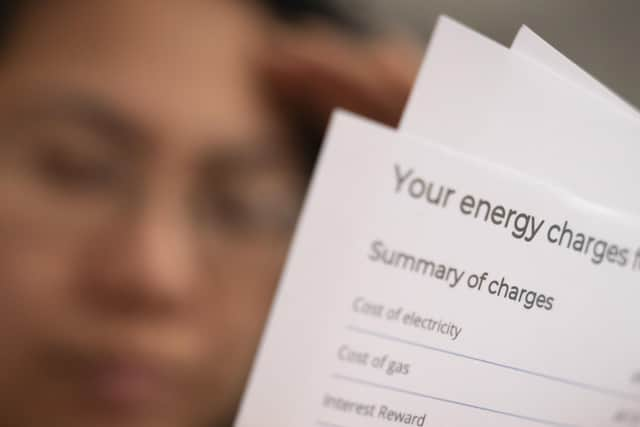What does the energy price cap mean? How does the Ofgem energy price cap work? UK energy price cap 2022 rise
The energy price cap has risen by 80%, rising the average household’s annual bill to £3,549 from October.
Ofgem confirmed the news on Friday (August 26), which is expected to affect around 24 million households across the UK.
Advertisement
Hide AdAdvertisement
Hide AdIt comes after the energy regulator revealed changes to the price cap which means prices will update every three months rather than six.


The energy markets authority also warned of a ‘very challenging winter ahead’ with the cost of living crisis linked to energy prices set to deepen.
The regulator argues the changes to the cap will offer stability for the market which has been struck by Russia’s invasion of Ukraine. Ofgem said it is “not in anyone’s interests for more suppliers to fail and exit the market”.
So what is the energy price cap, what are the changes to the price cap, why are bills likely to keep rising and what can be done to cope?
What is the energy price cap? What does it mean?
Introduced by the UK Government in 2019 and regulated by energy regulator Ofgem – originally the Office of Gas and Electricity Markets – the energy price cap places a limit on how much suppliers can charge UK households on default tariffs.
The price cap regulates the cost of energy units and is supposed to ensure that customers do not pay excessive amounts for their gas or electricity – or are not vulnerable to competitive behaviour of dominant market players. It is currently reviewed by regulator Ofgem every three months based on a set of rules.
How does the energy price cap work?
A key part of its role is to set a limit – the price cap – on what energy firms charge customers on default, or standard variable, tariffs.
Variable tariffs have previously been more expensive than fixed-rate deals and people are often on these tariffs if they have never switched suppliers, a fixed term has ended or their supplier has gone bust.
Advertisement
Hide AdAdvertisement
Hide AdThere is also a separate price cap for customers on prepayment meters.
On a standard energy bill, the price cap governs the maximum standing charge and price per kWh of gas and electricity that your supplier can charge you.
How much is the energy price cap 2022?
Ofgem revealed on Friday (August 26) the energy price cap is expected to increasing by a further £1,971 to £3,549 from October 1. That is an 80% increase from 2021.
Jonathan Brearly, Ofgem’s CEO, said: “We know the massive impact this price cap increase will have on households across Britain and the difficult decisions consumers will now have to make. I talk to customers regularly and I know that today’s news will be very worrying for many.”
He said the price of energy has reached record levels due to an “aggressive econonmic act” by Russia after its invasion of Ukraine.
“They have slowly and deliberately turned off the gas supplies to Europe causing harm to our households, businesses and wider economy. Ofgem has no choice but to reflect these cost increases in the price cap.”
Ofgem has now confirmed it will update the price cap quarterly because the market is moving so quickly and it is not sustainable for people to pay a rate up to six months old.
Why are energy prices increasing?
Advertisement
Hide AdAdvertisement
Hide AdThe recent surge in energy prices has been driven by wholesale prices, specifically the soaring cost of gas.
Gas prices on global markets have surged by as much as six-fold, having leapt higher before the invasion of Ukraine.
Last year, countries in Asia and Europe used significant amounts of gas stocks during a long winter which helped to drive up prices while the reopening of economies also sparked higher energy usage.
More recently, the invasion of Ukraine by Russia has led to a restriction of Russian gas which has in turn pushed prices higher.
In the UK, very little gas is sourced from Russia but this has not shielded suppliers from the pricing impact across the rest of Europe, which typically sourced around 40% of natural gas from Russia.
What can customers do if they are worried about their rising energy bills?
Ofgem suggests contacting your supplier as soon as you can if you are worried about paying your energy bills or are in debt to your supplier.
Suppliers must work with you to agree on a payment plan customers can afford under Ofgem rules.
People can ask for more time to pay, access to hardship funds and payment breaks or reductions under the potential options.
Advertisement
Hide AdAdvertisement
Hide AdSome energy companies offer certain schemes, for example, if someone is making their home more energy-efficient or offering free boiler checks and upgrades.
Some people may also qualify for particular forms of help such as Winter Fuel Payments or the Warm Home Discount Scheme. Some charities may be able to offer grants.
Additional reporting by PA.
Comments
Want to join the conversation? Please or to comment on this article.

